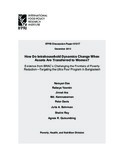| dc.description.abstract | Growing evidence shows that the distribution of individuals’ ownership and control of assets within a household can have important implications for women’s empowerment and children’s well-being. Interventions that target assets to specific individuals can shift these intra-household dynamics, yet little evidence exists from rigorous evaluations. We study BRAC’s Challenging the Frontiers of Poverty Reduction—Targeting the Ultra Poor (CFPR-TUP) program in Bangladesh, which targets asset transfer (primarily livestock) and training to rural women in poor households. In this paper, we examine intra-household impacts using mixed methods. We focus on the Specially Targeted Ultra-Poor (STUP) component of the program, which targets households selected following a Randomized Controlled Trial design. Adding a new round of data collection with quantitative sex-disaggregated information and qualitative exploration, we exploit the randomized design to assess intra-household impacts of STUP. Our analysis confirms that the program significantly increases household ownership of various assets but has complex effects on the targeted women. Quantitative estimates show increases in women’s sole and joint ownership of or control over transferred assets such as livestock, but a much greater increase in men’s sole ownership over nearly all other assets (including agricultural and non-agricultural productive assets, land, and consumer durables). These findings suggest that while the transferred assets tend to remain with women, new investments from mobilized resources are controlled by men. Moreover, the program reduces women’s mobility outside the home and their control over income, consistent with the transferred asset’s requiring maintenance at home. Qualitative findings are consistent with these quantitative results, but women’s contribution to their households is perceived as increasing their confidence and social capital, which they themselves value. The analysis shows that asset transfer targeted to women can increase women’s ownership of and control over the transferred asset itself but may not necessarily increase women’s intra-household bargaining position. Moreover, it reveals that outcomes valued by individuals may not always be tangible, highlighting the complexity of assessing whether interventions improve women’s empowerment. | en_US |

